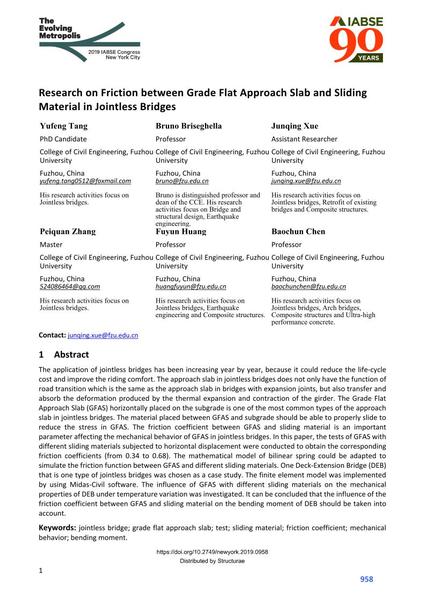Research on Friction between Grade Flat Approach Slab and Sliding Material in Jointless Bridges

|
|
|||||||||||
Bibliografische Angaben
| Autor(en): |
Yufeng Tang
(College of Civil Engineering, Fuzhou University)
Bruno Briseghella Junqing Xue (College of Civil Engineering, Fuzhou University) Peiquan Zhang (College of Civil Engineering, Fuzhou University) Fuyun Huang (College of Civil Engineering, Fuzhou University) Baochun Chen (College of Civil Engineering, Fuzhou University) |
||||
|---|---|---|---|---|---|
| Medium: | Tagungsbeitrag | ||||
| Sprache(n): | Englisch | ||||
| Tagung: | IABSE Congress: The Evolving Metropolis, New York, NY, USA, 4-6 September 2019 | ||||
| Veröffentlicht in: | The Evolving Metropolis | ||||
|
|||||
| Seite(n): | 958-962 | ||||
| Anzahl der Seiten (im PDF): | 5 | ||||
| DOI: | 10.2749/newyork.2019.0958 | ||||
| Abstrakt: |
The application of jointless bridges has been increasing year by year, because it could reduce the life‐cycle cost and improve the riding comfort. The approach slab in jointless bridges does not only have the function of road transition which is the same as the approach slab in bridges with expansion joints, but also transfer and absorb the deformation produced by the thermal expansion and contraction of the girder. The Grade Flat Approach Slab (GFAS) horizontally placed on the subgrade is one of the most common types of the approach slab in jointless bridges. The material placed between GFAS and subgrade should be able to properly slide to reduce the stress in GFAS. The friction coefficient between GFAS and sliding material is an important parameter affecting the mechanical behavior of GFAS in jointless bridges. In this paper, the tests of GFAS with different sliding materials subjected to horizontal displacement were conducted to obtain the corresponding friction coefficients (from 0.34 to 0.68). The mathematical model of bilinear spring could be adapted to simulate the friction function between GFAS and different sliding materials. One Deck‐Extension Bridge (DEB) that is one type of jointless bridges was chosen as a case study. The finite element model was implemented by using Midas‐Civil software. The influence of GFAS with different sliding materials on the mechanical properties of DEB under temperature variation was investigated. It can be concluded that the influence of the friction coefficient between GFAS and sliding material on the bending moment of DEB should be taken into account. |
||||
| Stichwörter: |
Versuch Test Biegemoment Reibungsbeiwert
|
||||
